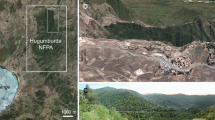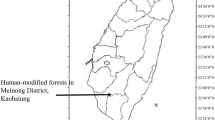Abstract
Hydric forest communities within the Tampa Bay Watershed were inventoried to assess the effect of urbanization on these systems. Based on aerial photography and site visits, 85 hydric plots were assigned a legacy class—remnant (forest, pre-1948), emergent (forest, post 1948), and managed (actively managed grass on plot). On each plot, diameter at breast height (dbh) and canopy width and species were recorded for trees ≥2.5 cm dbh. A hierarchical agglomerative cluster analysis identified community types within a legacy class and one-way AOV (α = .05) was used to compare structural features within and among legacy classes. Remnant plots (43 plots) were composed of six, natural community types as recognized by the Florida Natural Areas Inventory and no novel communities. Emergent plots (23 plots) were composed of four natural community types and one novel community. Managed plots (19 plots) contained only novel communities. Remnants had the highest species richness (41 species) and only one non-native species. Managed had the lowest species richness (33 species) but highest richness of non-native species (17). Remnant and emergent plots had similar densities for trees ≤32 cm dbh, (803 and 820 stems/ha, respectively), whereas managed plots had only 119 stems/ha. For trees >32 cm dbh, remnant plots had a significantly higher density (196 stems/ha) than emergent (99 stems/ha) and managed (40 stems/ha). These results suggest that legacy did not play a key role in differentiating between emergent and remnant plots but did play a key role in identifying managed plots.



Similar content being viewed by others
References
Baldwin AH (2011) Plant communities of urban wetlands: patterns and controlling processes. In: Niemelä J (ed) Urban ecology and: patterns, processes, and applications. Oxford University Press, New York, pp 77–84
Curtis JT, McIntosh RP (1951) An upland forest continuum in the prairie-forest border region of Wisconsin. Ecology 72:476–496
Ehrenfeld JG (2008) Exotic invasive species in urban wetlands: environmental correlates and immplications for wetland management. J Appl Ecol 45:1160–1169
Ehrenfeld JG, Schneider JP (1991) Chamaecyparis thyoides wetlands and suburbanization: effects on hydrology, water quality and plant community composition. J Appl Ecol 28:467–490
Faulkner S (2004) Urbanization impacts on the structure and function of forested wetlands. Urban Ecosyst 7(2):89–106
FDEP (2011) Learn about your watershed: Tampa Bay Watershed Florida Department of Environmental Protection. http://www.protectingourwater.org/watersheds/map/tampa_bay/. Accessed June 1 2012
FLEPPC (2011) List of invasive plant species. Florida Exotic Pest Plant Council. http://www.fleppc.org/list/11list.htm. Accessed June 5 2012
FNAI (2010) Guide to the natural communities of Florida: 2010 edition. Florida natural areas inventory, Tallahassee, FL
Friedman MH (2011) Characterizating natural vegetative communities near freshwater hydrological features in an urbanizing watershed of west Central Florida. University of Florida, Gainesville
Friedman MH, Andreu MG, Zipperer WC, Northrop RJ, Abd-Elrahman A (2015) Species composition of forested natural communities near freshwater hydrological features in an urbanizing watershed of west Central Florida. Florida Sci 78(3):111–129
Groffman PM, Bains JB, Band LE, Belt KT, Brush GS, Grove JM, Pouyat RV, Yesilonis IC, Zipperer WC (2003) Down by the riverside: urban riparian ecology. Front Ecol Environ 1:315–321
Lau MK (2011) Dunnett-Tukey-Kramer pairwise multiple comparison test adjusted for unequal variances and unequal sample sizes. R package Version 3.1. http://CRAN.R-project.org/package=DTK. Accessed June 5 2012
Levenson JB (1981) Woodlots as biogeographic islands in southeastern Wisconsin. In: Burgess RL, Sharpe DM (eds) Forest island dynamics in man-dominated landscapes. Springer-Verlag, New York, pp 13–40
Matlack GR (1993) Microenvironment variation within and among forest edge sites in the eastern United States. Biol Conserv 66:185–194
McCune B, Grace JB (2002) Analysis of Ecological Communities. mjm Software Design, Gleneden Beach, OR
Messina MG, Conner WH (1998) Southern forested wetlands: ecology and management. CRC Press, Boca Raton
Muratet A, Porcher E, Devictor V, Arnal G, Moret J, Wright S, Machon N (2008) Evaluation of floristic diversity in urban as a basis for habitat management. Appl Vege Manag 11:451–460
Ranney JW, Bruner MC, Levenson JB (1981) The importance of edge in the structure and dynamics of forest islands. In: Burgess RL, Sharpe DM (eds) Forest Island dynamics in man-dominated landscapes. Springer-Verlag, New York, pp 67–96
USGS (2010) Boundary descriptions and names of regions, subregions, accounting units, and cataloging units. United States Geological Survey. http://water.usgs.gov/GIS/huc_name.html. Accessed June 1 2012
Welch BL (1947) The generalization of 'Student's' problem when several different population variances are involved. Biometrika 34:28–35
Wunderlin RP, Hansen BF (2008) Atlas of Florida's vascular plants. Institute for Systematic Botany, University of Florida. http://www.plantatlas.usf.edu. Accessed May 28 2012
Xian G, Crane M, Su J (2007) An analysis of urban development and its environmental impact on the Tampa Bay watershed. J Environ Manag 85:965–976
Zipperer WC (2002) Species composition and structure of regenerated and remnant forest patches within an urban landscape. Urban Ecosyst 6:271–290
Zipperer WC, Foresman TW, Sisinni SM, Pouyat RV (1997) Urban tree cover: an ecological perspective. Urban Ecosyst 1:229–246
Author information
Authors and Affiliations
Corresponding author
Appendix 1
Appendix 1
Rights and permissions
About this article
Cite this article
Lagrosa, J.J., Andreu, M.G., Friedman, M.H. et al. Effect of legacy on hydric forest structure in a subtropical urban watershed. Urban Ecosyst 24, 49–58 (2021). https://doi.org/10.1007/s11252-020-01009-y
Published:
Issue Date:
DOI: https://doi.org/10.1007/s11252-020-01009-y




